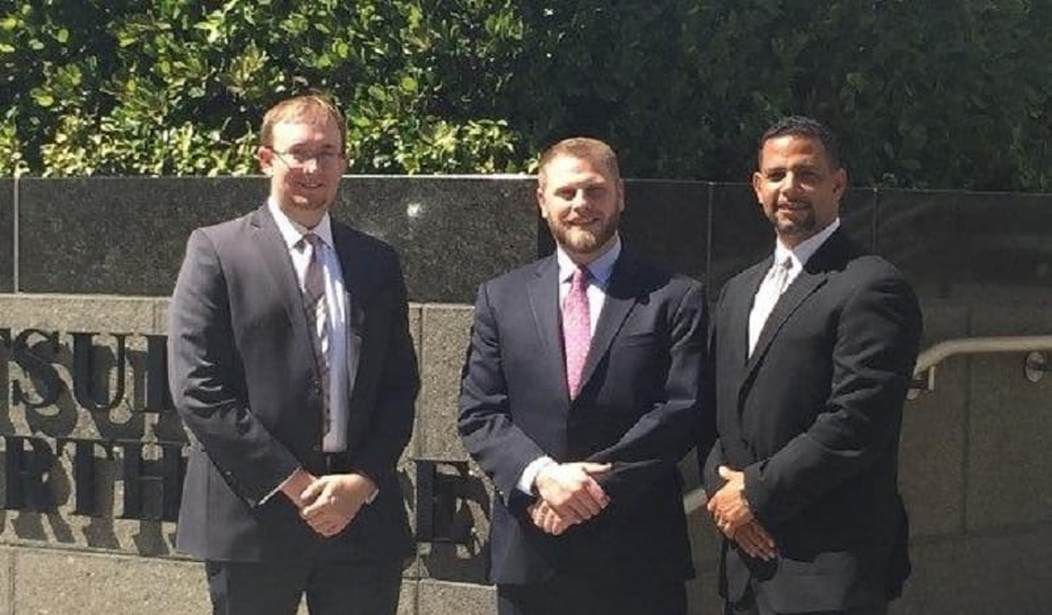For the past few weeks the topics gun control and school safety have dominated public conversation. How can we keep guns out of the hands of dangerous or mentally ill people? How can we make sure that when we drop our children off at school, that we’re delivering them to a safe environment and not one in which they’re vulnerable?
I asked Brandon Combs, President of Firearms Policy Coalition, about these topics in an exclusive interview. Brandon has been at the center of gun policy and Second Amendment advocacy, particularly in California, for more than a decade. He was an individually named plaintiff in the recent Silvester v. Becerra 10-day waiting period case in which the Supreme Court denied cert (and in which Justice Thomas wrote a scathing dissent). Firearms Policy Coalition also has a case pending before the 9th Circuit Court of Appeals challenging California’s ban on concealed carry permit holders possessing their weapons on school grounds.
Gun Violence Restraining Orders have been in the news a lot in the last week, with some conservatives touting them as a way to “do something.” Even Sen. Rubio seemingly endorsed them in last night’s CNN Town Hall. California enacted such a statute after the Isla Vista (UCSB) shooting, and you were involved in that process. What does the California statute provide for?
First of all, I think it’s pretty fair to say that California has the model that most gun control advocates generally look to when they’re pushing their agenda in other states. We run into virtually-identical language in bills all over the country. And, of course, they’d love to see California-style laws enacted federally.
Back in 2014, the California Legislature rammed through, and Governor Jerry Brown signed, Assembly Bill 1014—which started out as a renewable energy bill, but was “gutted and amended” into a gun control bill—creating a few different kinds of so-called “Gun Violence Restraining Orders,” including two procedures for ex parte GVRO proceedings. That means a petitioning law enforcement officer or qualified family member gets to present their arguments to the court and the subject of the petition is not necessarily present, or even aware, of the petition and hearing. It also created a procedure for a GVRO to be issued after notice and a hearing.
Keep in mind that even if there was “notice” given, that does not mean the subject of the petition must personally know about it. So GVROs can be issued either immediately against someone who doesn’t know (in the case of an ex parte proceeding) or after many days or weeks (after notice and a hearing). And even if a GVRO is issued, they are to be personally served on the subject only “if the restrained person can reasonably be located.” All of these factors undermine the entire basis for GVROs. [Ed. Note: Under California’s statute, an ex parte GVRO expires after 21 days, but can be expanded to a year after a hearing.]
Also deeply troubling is that, in California’s GVRO system, a court “may consider any other evidence of an increased risk for violence, including, but not limited to….[e]vidence of recent acquisition of firearms, ammunition, or other deadly weapons.” In other words, if you recently exercised your Second Amendment rights, that could be construed as evidence that you are an “increased risk for violence” and should have a GVRO issue against you.
Wow. So if you buy some ammo to go shoot at the range, that’s evidence that you are an “increased risk for violence” and judges have discretion to decide what constitutes evidence of increased risk? That’s truly frightening. What are the pros, if any, and cons of the GVRO system?
The GVRO system has some very serious flaws, both as a practical matter and in terms of constitutional law. Even setting aside those constitutional concerns, we have never seen any persuasive argument that GVROs provide a material social benefit or increase to public safety over other laws on the books.
First, in an ex parte situation, the subject of an order might not even know about it, let alone voluntarily decide to give up their property once they do know. And if it’s an order issued after notice and a hearing, then that subject, if they really are dangerous, gets to maintain possession of weapons until someone takes their weapons from them—if they can find them—or until there’s a warrant, search, and seizure of property. It’s not an immediate action, if there’s any real action taken at all, so GVROs operate on the presumption that people subject to an order are voluntarily going to be law-abiding until their guns are taken away from them, if ever. If someone is really insane or plain evil, that seems like a very irrational and dangerous presumption.
Due process is the main argument most people make against GVRO’s, and that’s absolutely a huge problem. In addition to that issue, what are the problems you see with GVRO’s from both a liberty and an effectiveness standpoint?
Of course, many GVROs and their underlying statutes skip past due process. We’ve said that from the beginning. A firearm is personal property, of course, but the interest at stake here is far more substantial than the deprivation of a mere possession. As the Supreme Court held in McDonald v. City of Chicago, “[T]he right to keep and bear arms” is “among those fundamental rights necessary to our system of ordered liberty.” By establishing a scheme that prohibits the possession or compels the seizure of firearms, GVROs strike at the core of the Second Amendment: the right to keep and bear arms for self-defense.
If someone is dangerous enough, due to criminal activity or mental health problems, to be a real threat to themselves or others, then there are many laws by which families, friends, or law enforcement can respond to them. But if the government doesn’t have enough to charge a person with a crime and investigate them, or hold them for a mental health evaluation, then that’s not a good enough basis to take away rights and property. It’s the government job to carry its burden, not ours.
The presumption of innocence is hanging by a thread, and GVROs stand for the proposition that everyone is guilty unless they can prove their way out of an accusation.
Tools such as 72-hour holds (known by various names around the country) and restraining orders have been available for decades. Wouldn’t those serve the same purpose if enforced properly, or are there modifications that could be made to those types of statutes? Do we truly need a separate new law?
We believe that GVROs are really about two things, and, regardless of how they’re sold, they have nothing to do with making America safer. First of all, GVROs play a key role in the “funnel” of gun control – put people into lists and database, ban guns, ban people, take away guns, arrest people. We talk about that a bit in an old editorial we wrote about “compromise” on gun control.
And, of course, California has many mental health laws that have been on the books for decades, like those in Welfare and Institutions Code § 5150, et seq. If someone is a real danger to themselves or others, they can be taken in for an evaluation. If there is cause, they can be held. In California, these things can trigger gun prohibitions, too. And at least here, if someone is mentally unstable, they’re in the care of professionals and away from any weapons they might otherwise be able to access.
Our position is that we don’t need more laws and we don’t need GVROs to tackle these issues. As even Governor Brown said in a 2015 veto message, “California’s criminal code has grown to more than 5,000 separate provisions, covering almost every conceivable form of human misbehavior.” No one knows that better than we law-abiding gun owners and advocates do.
Murder, manslaughter, and assault are crimes that are illegal everywhere. If a state doesn’t have adequate or appropriate mental health codes, then they should address that problem. But GVROs are an ineffective way to deal with mental health, because they don’t. And they don’t address the fundamental problems inherent to violent criminals, either. The bottom line is,that there were plenty of legal ways to deal with criminals and mentally unstable people before GVROs. So, not only are GVROs ineffective, they were totally unnecessary.
“Compromise” on gun control usually just means giving the gun control lobby a piece of your cake and expecting them to not come back and demand the rest of it. But we know they will.
Exactly. This GVRO issue is really a never-ending battle. Once the framework is in place, they will never stop adding to it. Just two years after they passed AB 1014, Assemblymember Phil Ting (D – San Francisco) authored and passed AB 2607, which would have vastly expanded the number and kind of people who could petition for a GVRO to take away someone’s guns, ammunition, and Second Amendment rights. Thankfully, Governor Brown vetoed the bill, but Assemblymember Ting recently said that he would be introducing it again with perhaps even broader language.
Ah, yes, I remember that bill and writing about it back then. It stuck with me because it would have allowed anyone who had even gone to school with a subject over the previous six months to file for one. If I recall, a bunch of mental health professional organizations and the ACLU even opposed it. Do you think Brown will veto it again, if passed?
Everyone knows that Governor Brown has signed bills that he previously vetoed, like he did with the “Gunpocalypse” gun control bills in 2016, so our team will have a lot of work to do in the Legislature this year. And if Gavin Newsom becomes the next governor, and that seems very possible at this point, all bets are off.
Gavin Newsom. A name that makes all Second Amendment advocates in California shudder. It used to be that Kamala Harris was our chief nemesis, but sadly our voters decided to share her with the rest of the country.
Well, as Newsom – who championed the Proposition 63 gun control ballot initiative – said, “As California goes, so goes the rest of the nation.” We think he’s generally right about that, which is why gun owners everywhere should never assume their so-called “free” state will stay that way. If you have better access to rights in your state that someone in California or New Jersey doesn’t have access to, it’s probably because of your state’s constitution or statutes and not the enforcement of the federal Second Amendment right to keep and bear arms.
And billionaires are dumping big money into ballot initiatives to prey on political ignorance. It’s cheaper for them to dump ten or twenty million into a statewide ballot measure once than to work in legislative efforts for three, five, ten years. Gun rights groups can be pretty effective in the legislative process because many elected members and committee staffers will generally hear out practical objections and some legal arguments even if they are anti-gun in general. But on money-driven things like a ballot initiative, anti-gun billionaires have a massive advantage. Bloomberg and his people know it, too.
But our fundamental rights don’t have borders, they don’t stop at state or county or city lines, and we should never abandon our brothers and sisters behind enemy lines. Otherwise you will eventually have California-style laws, New Jersey-style laws—at least some of them, probably the worst ones—everywhere. An attack on Second Amendment rights anywhere is an attack on Second Amendment rights everywhere. We need to never forget that.
Part 2 of my interview with Firearms Policy Coalition’s Brandon Combs, covering school security and the issue of guns in schools, will be published Sunday.














Join the conversation as a VIP Member